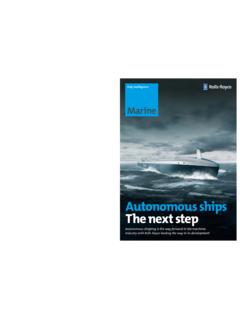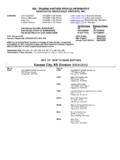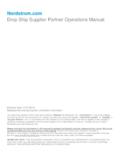Transcription of EXPLANATORY NOTES TO THE STANDARDS FOR …
1 INTERNATIONAL MARITIME ORGANIZATION. 4 ALBERT EMBANKMENT. LONDON SE1 7SR E. Telephone: 020 7735 7611. Fax: 020 7587 3210. Telex: 23588 IMOLDN G IMO. Ref. T4 16 December 2002. EXPLANATORY NOTES TO THE STANDARDS FOR ship MANOEUVRABILITY. 1 The Maritime Safety Committee, at its seventy-sixth session (2 to 13 December 2002), adopted resolution (76) on STANDARDS for ship manoeuvrability. In adopting the STANDARDS , the Committee recognized the necessity of appropriate EXPLANATORY NOTES for the uniform interpretation, application and consistent evaluation of the manoeuvring performance of ships. 2 To this end, the Maritime Safety Committee, at its seventy-sixth session (2 to 13 December 2002), approved the EXPLANATORY NOTES to the STANDARDS for ship manoeuvrability (resolution (76)), set out in the annex to the present circular, as prepared by the Sub- Committee on ship Design and Equipment at its forty-fifth session.
2 3 The EXPLANATORY NOTES are intended to provide Administrations with specific guidance to assist in the uniform interpretation and application of the STANDARDS for ship manoeuvrability and to provide the information necessary to assist those responsible for the design, construction, repair and operation of ships to evaluate the manoeuvrability of such ships. 4 Member Governments are invited to: .1 use the EXPLANATORY NOTES when applying the STANDARDS contained in resolution (76); and .2 use the form contained in appendix 5 of the annex to the present circular if submitting manoeuvring data to the Organization for consideration, as appropriate. 5 This circular supersedes **. I:\CIRC\MSC\ ANNEX. EXPLANATORY NOTES TO THE STANDARDS . FOR ship MANOEUVRABILITY. CHAPTER 1. GENERAL PRINCIPLES. Philosophy and background The purpose of this section is to provide guidance for the application of the STANDARDS for ship Manoeuvrability (resolution (76)) along with the general philosophy and background for the STANDARDS .
3 Manoeuvring performance has traditionally received little attention during the design stages of a commercial ship . A primary reason has been the lack of manoeuvring performance STANDARDS for the ship designer to design to, and/or regulatory authorities to enforce. Consequently some ships have been built with very poor manoeuvring qualities that have resulted in marine casualties and pollution. Designers have relied on the shiphandling abilities of human operators to compensate for any deficiencies in inherent manoeuvring qualities of the hull. The implementation of manoeuvring STANDARDS will ensure that ships are designed to a uniform standard, so that an undue burden is not imposed on shiphandlers in trying to compensate for deficiencies in inherent ship manoeuvrability. IMO has been concerned with the safety implications of ships with poor manoeuvring characteristics since the meeting of the Sub-Committee on ship Design and Equipment (DE) in 1968.
4 Titled "Interim Guidelines for Estimating Manoeuvring Performance in ship Design", dated 10 January 1985, encourages the integration of manoeuvrability requirements into the ship design process through the collection and systematic evaluation of ship manoeuvring data. Subsequently, the Assembly, at its fifteenth session in November 1987, adopted resolution (15), entitled "Provision and Display of Manoeuvring Information on board Ships". This process culminated at the eighteenth Assembly in November 1993, where "Interim STANDARDS for ship Manoeuvrability" were adopted by resolution (18). After the adoption of resolution (18), the Maritime Safety Committee, at its sixty-third session, approved titled EXPLANATORY NOTES to the Interim STANDARDS for ship manoeuvrability , dated 6 June 1994, to provide Administrations with specific guidance so that adequate data could be collected by the Organization on the manoeuvrability of ships with a view to amending the aforementioned Interim STANDARDS .
5 This process culminated at the seventy-sixth session of the Maritime Safety Committee in December 2002, where STANDARDS for ship manoeuvrability were adopted by resolution (76). The STANDARDS were selected so that they are simple, practical and do not require a significant increase in trials time or complexity over that in current trials practice. The STANDARDS are based on the premise that the manoeuvrability of ships can be adequately judged from the results of typical ship trials manoeuvres. It is intended that the manoeuvring performance of a ship be designed to comply with the STANDARDS during the design stage, and that the actual manoeuvring characteristics of the ship be verified for compliance by trials. Alternatively, the compliance with the STANDARDS can be demonstrated based on the results of full-scale trials, although the Administration may require remedial action if the ship is found in substantial disagreement with the STANDARDS .
6 Upon completion I:\CIRC\MSC\ ANNEX. Page 2. of ship trials, the shipbuilder should examine the validity of the manoeuvrability prediction methods used during the design stage. Manoeuvring characteristics The "manoeuvring characteristics" addressed by the IMO STANDARDS for ship manoeuvrability are typical measures of performance quality and handling ability that are of direct nautical interest. Each can be reasonably well predicted at the design stage and measured or evaluated from simple trial-type manoeuvres. Manoeuvring characteristics: general In the following discussion, the assumption is made that the ship has normal actuators for the control of forward speed and heading ( , a stern propeller and a stern rudder). However, most of the definitions and conclusions also apply to ships with other types of control actuators. In accepted terminology, questions concerning the manoeuvrability of a ship include the stability of steady-state motion with "fixed controls" as well as the time-dependent responses that result from the control actions used to maintain or modify steady motion, make the ship follow a prescribed path or initiate an emergency manoeuvre, etc.
7 Some of these actions are considered to be especially characteristic of ship manoeuvring performance and therefore should be required to meet a certain minimum standard. A ship operator may choose to ask for a higher standard in some respect, in which case it should be remembered that some requirements may be mutually incompatible within conventional designs. For similar reasons the formulation of the IMO STANDARDS for ship manoeuvrability has involved certain compromises. Manoeuvring characteristics: some fundamentals At a given engine output and rudder angle , the ship may take up a certain steady motion. In general, this will be a turning motion with constant yaw rate , speed V and drift angle (bow-in). The radius of the turn is then defined by the following relationship, expressed in consistent units: R = V/ . This particular ship -rudder angle configuration is said to be "dynamically stable in a turn of radius R".
8 Thus, a straight course may be viewed as part of a very wide circle with an infinite radius, corresponding to zero yaw rate. Most ships, perhaps, are "dynamically stable on a straight course" (usually referred to as simply "dynamically stable") with the rudder in a neutral position close to midship. In the case of a single screw ship with a right-handed propeller, this neutral helm is typically of the order o = -1 . ( , 1 to starboard). Other ships which are dynamically unstable, however, can only maintain a straight course by repeated use of rudder control. While some instability is fully acceptable, large instabilities should be avoided by suitable design of ship proportions and stern shape. The motion of the ship is governed mainly by the propeller thrust and the hydrodynamic and mass forces acting on the hull. During a manoeuvre, the side force due to the rudder is often small compared to the other lateral forces.
9 However, the introduced controlling moment is mostly sufficient to balance or overcome the resultant moment of these other forces. In a steady turn there is I:\CIRC\MSC\ ANNEX. Page 3. complete balance between all the forces and moments acting on the hull. Some of these forces seeming to "stabilize" and others to "destabilize" the motion. Thus the damping moment due to yaw, which always resists the turning, is stabilizing and the moment associated with the side force due to sway is destabilizing. Any small disturbance of the equilibrium attitude in the steady turn causes a change of the force and moment balance. If the ship is dynamically stable in the turn (or on a straight course) the net effect of this change will strive to restore the original turning (or straight). motion. The general analytical criterion for dynamic stability may be formulated and evaluated with the appropriate coefficients of the mathematical model that describes the ship 's motion.
10 The criterion for dynamic stability on a straight course includes only four "linear stability derivatives" which together with the centre-of-gravity position, may be used to express the "dynamic stability lever". This lever denotes the longitudinal distance from the centre-of-pressure of the side force due to pure sway (or sideslip) to the position of the resultant side force due to pure turning, including the mass force, for small deviations from the straight-line motion. If this distance is positive (in the direction of positive x, towards the bow) the ship is stable. Obviously "captive tests" with a ship model in oblique towing and under the rotating arm will furnish results of immediate interest. It is understood that a change of trim will have a marked effect mainly on the location of the centre-of-pressure of the side force resulting from sway. This is easily seen that a ship with a stern trim, a common situation in ballast trial condition, is likely to be much more stable than it would be on an even draught.






![Navy LPD-17 Flight II (LX[R]) Amphibious Ship …](/cache/preview/9/3/7/c/b/8/6/4/thumb-937cb86438c311f5168c0ab2393b37b5.jpg)